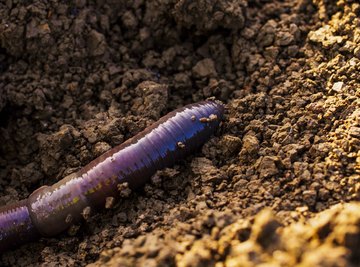
One of the biggest differences between blackworms (Lumbriculus variegatus) and earthworms (Lumbricus terrestris) is their habitats. Blackworms, also known as California blackworms or mudworms, like mud and prefer to live in shallow water. Earthworms, sometimes called night crawlers, are the large worms that surface in your garden after a good rain. They live on land, burrowing deep into loose, rich soil and making it richer with their castings.
The two worms are different in appearance and represent different orders of worms, but scientists class them both as Oligochaeta, which gives them several features in common. This is but one class in the phylum Annelida – the ringed or segmented worms – which has some 22,000 species.
Blackworms and Earthworms Are Red-Blooded
Earthworms and mud worms both make good bait, and when you're putting one on a hook, you might notice a drip of red blood. The coloration is due to the presence of erythrocruorin, a pigment related to hemoglobin, which makes human blood red. Neither of these worms has a heart to circulate the blood. This function is served by rhythmic pulsations of the dorsal blood vessel.
If you're wondering which end is dorsal, watch the worm crawl. The head usually goes first. Both blackworms and earthworms have different coloration on the anterior and dorsal ends, so you can tell the head from the tail even in the worm isn't moving. The head end of both species is usually larger than the tail, and it has darker coloration.
Both Worms Are Hermaphrodites
An individual blackworm or earthworm has both male and female reproductive organs, but it doesn't reproduce all by itself. It takes two worms to produce offspring. The worms lie alongside one another and become joined by a layer of mucus that each secretes. The sperm of each worm is transmitted to the other through this mucus layer and enters into a small sac. After the worms separate, each secretes a mucous cylinder, deposits the eggs and sperm, then wriggles out of the cylinder to allow the eggs to develop and hatch.
All Annelids Have Rings, All Oligochaetes Have Hair
As members of the phylum Annelida, both earthworms and blackworms have segmented bodies. Each segment is evidenced by a ring that completely encircles the worm's body and is separated from the one next to it by a membranous partition. Annelids have a fluid-filled section – the coelom – between the outer wall of the body and the gut. It is essentially a hydrostatic skeleton. It is divided into segments, and the worms use it for locomotion. Because the segments are independent of each other, the worm can lose part of its body and still survive. It simply regrows the part that was lost.
You'll never notice this when handling live blackworms or earthworms, but they have tiny hairs or bristles extending from each of their segments. This is a characteristic of all members of the class Oligochaeta. The hairs aid locomotion and may also help the worms sense their surroundings. Although it doesn't seem like it, both types of worms also have receptors that function as eyes. They are located on the ventral side and are so small and close together that you need a microscope to see them.
References
About the Author
Chris Deziel holds a Bachelor's degree in physics and a Master's degree in Humanities, He has taught science, math and English at the university level, both in his native Canada and in Japan. He began writing online in 2010, offering information in scientific, cultural and practical topics. His writing covers science, math and home improvement and design, as well as religion and the oriental healing arts.
